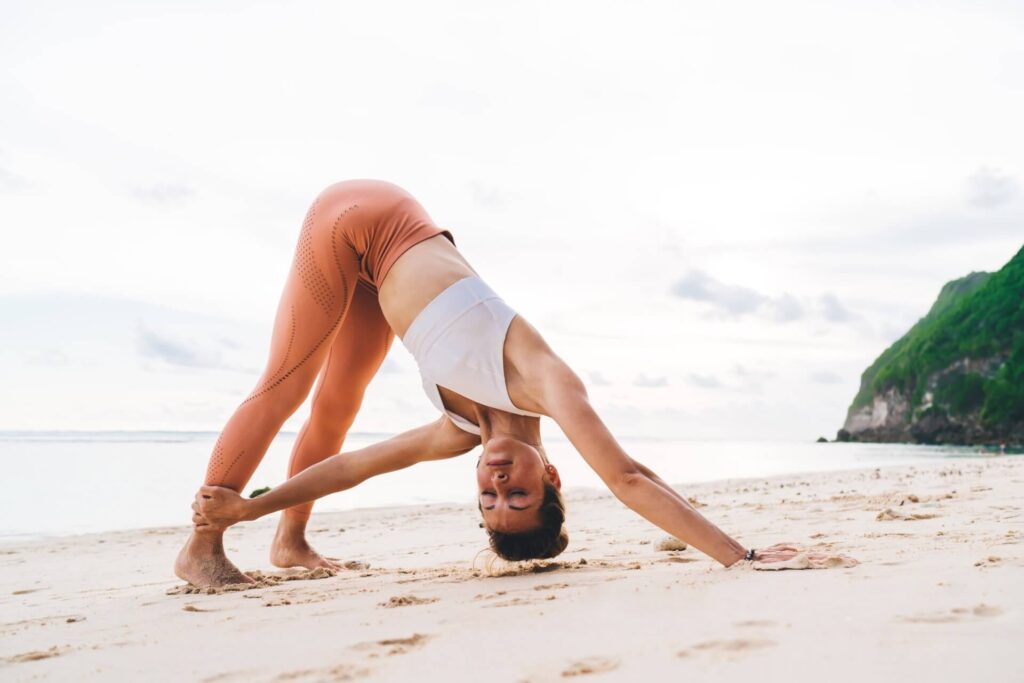“Parivrtta Adho Mukha Svanasana teaches us that true strength is found when we revolve and evolve, staying rooted in our practice while embracing the transformative power of twists.” Downward Facing Dog Revolved Parivrtta Adho Mukha Svanasana (Intermediate)
Downward-Facing Dog Revolved, known as Parivrtta Adho Mukha Svanasana in Sanskrit, is an intermediate-level yoga posture that combines strength, flexibility, and spinal rotation. In this asana, practitioners begin in the traditional Downward-Facing Dog pose (Adho Mukha Svanasana) and then twist their torso to open the chest and reach one arm toward the sky. Parivrtta Adho Mukha Svanasana offers an engaging challenge for those looking to advance their yoga practice beyond the basics.
Parivrtta Adho Mukha Svanasana is celebrated for its ability to engage the core, strengthen the shoulders, and enhance spinal mobility while promoting a sense of physical and mental awareness. It’s a pose that encourages both strength and mindfulness. Whether you’re progressing from an intermediate level or seeking to refine your practice, this comprehensive guide will introduce you to the essential techniques and alignment cues for Downward-Facing Dog Revolved, allowing you to experience its physical and mental benefits as an intermediate practitioner.
Parivrtta Adho Mukha Svanasana Meaning
Parivrtta Adho Mukha Svanasana, or Revolved Downward-Facing Dog Pose, combines the traditional Downward-Facing Dog with a twist. The name “Parivrtta Adho Mukha Svanasana” is derived from Sanskrit, signifying a rotated, downward-facing dog pose. In this asana, the practitioner starts in the classic Downward-Facing Dog and twists the torso, extending one arm upward.
Parivrtta Adho Mukha Svanasana symbolizes strength, balance, and adaptability, incorporating a twist into the foundational Downward Dog. It stretches and strengthens the shoulders, spine, and core muscles while promoting spinal flexibility. The pose also serves as a reminder to embrace change and find stability amid transformation, both in yoga practice and life’s transitions.
Strengths and Benefits Downward Facing Dog Revolved Parivrtta Adho Mukha Svanasana
- Spinal Flexibility: The twisting element enhances spinal flexibility, allowing for a broader range of motion.
- Core Engagement: Twisting requires a strong core, promoting stability and abdominal strength.
- Shoulder and Arm Strengthening: The weight-bearing aspect strengthens the shoulders, arms, and upper back.
- Digestive Aid: The twist aids in stimulating digestion and detoxification.
How to Perform Downward Facing Dog Revolved

Perform Downward-Facing Dog Revolved – Parivrtta Adho Mukha Svanasana with these steps:
- Starting Position: Begin in the classic Downward-Facing Dog. Spread your fingers wide, press your palms into the mat, and lift your hips upward.
- Twisting Motion: Shift your weight onto your left hand as you rotate your torso. Extend your right arm toward the sky, fingers pointing upward.
- Gaze Up: Turn your head to gaze at your right thumb.
- Stabilize Your Base: Maintain even weight distribution in your feet. Keep your legs engaged and strong.
- Hold and Breathe: Hold this twisted position for 20-30 seconds, breathing deeply and mindfully.
- Return to Downward Dog: Gently release the twist, returning to the standard Downward-Facing Dog.
- Switch Sides: Repeat the twist on the opposite side, raising your left arm this time.
Difficulty Level and Duration
Parivrtta Adho Mukha Svanasana falls within the intermediate level of yoga poses. Begin with 20-30 seconds of twisting on each side, gradually increasing the duration as you become more comfortable with the pose.
Final Thoughts
As we conclude our exploration of Parivrtta Adho Mukha Svanasana, remember that this asana offers more than physical benefits; it embodies the essence of transformation. Just as the body twists and turns, the mind and spirit evolve through the practice of yoga.
Elevate your practice with the Twisted Downward-Facing Dog, allowing its depth to inspire not only your physical strength but also your inner transformation. In the union of body, breath, and mind, you discover the path to balance and change, nurturing your overall well-being.


